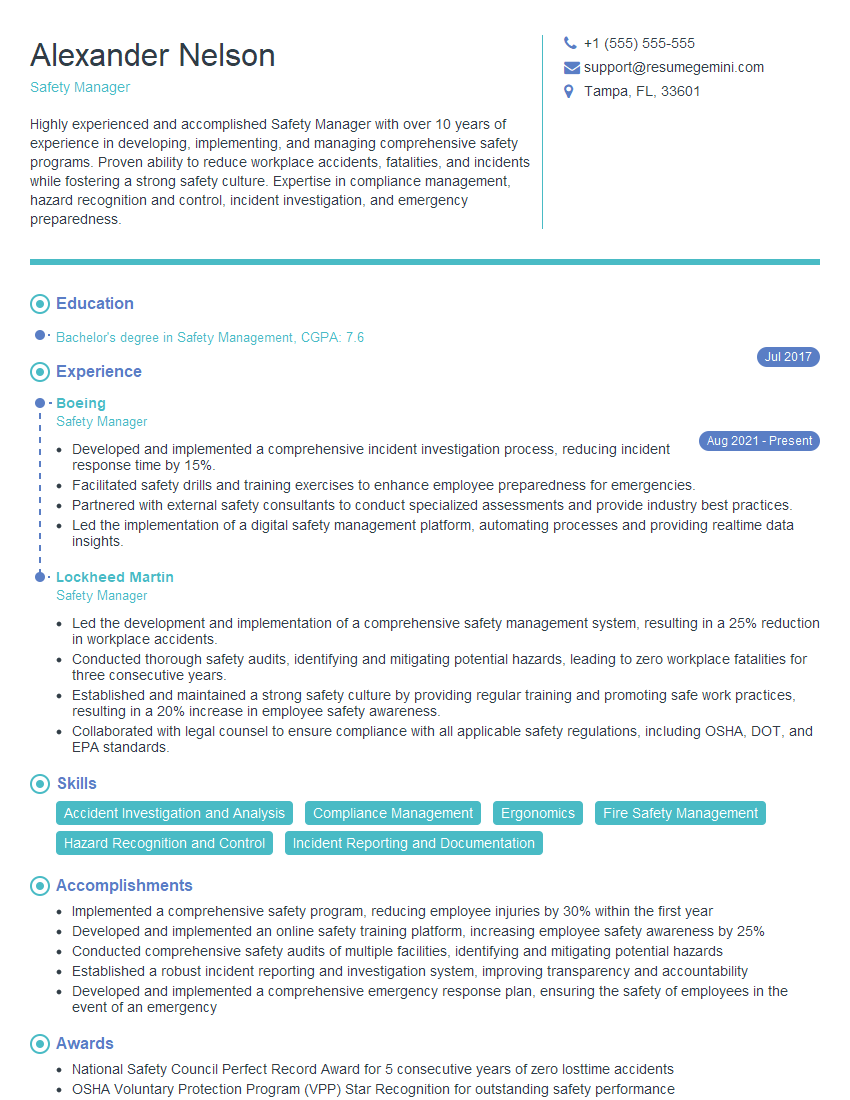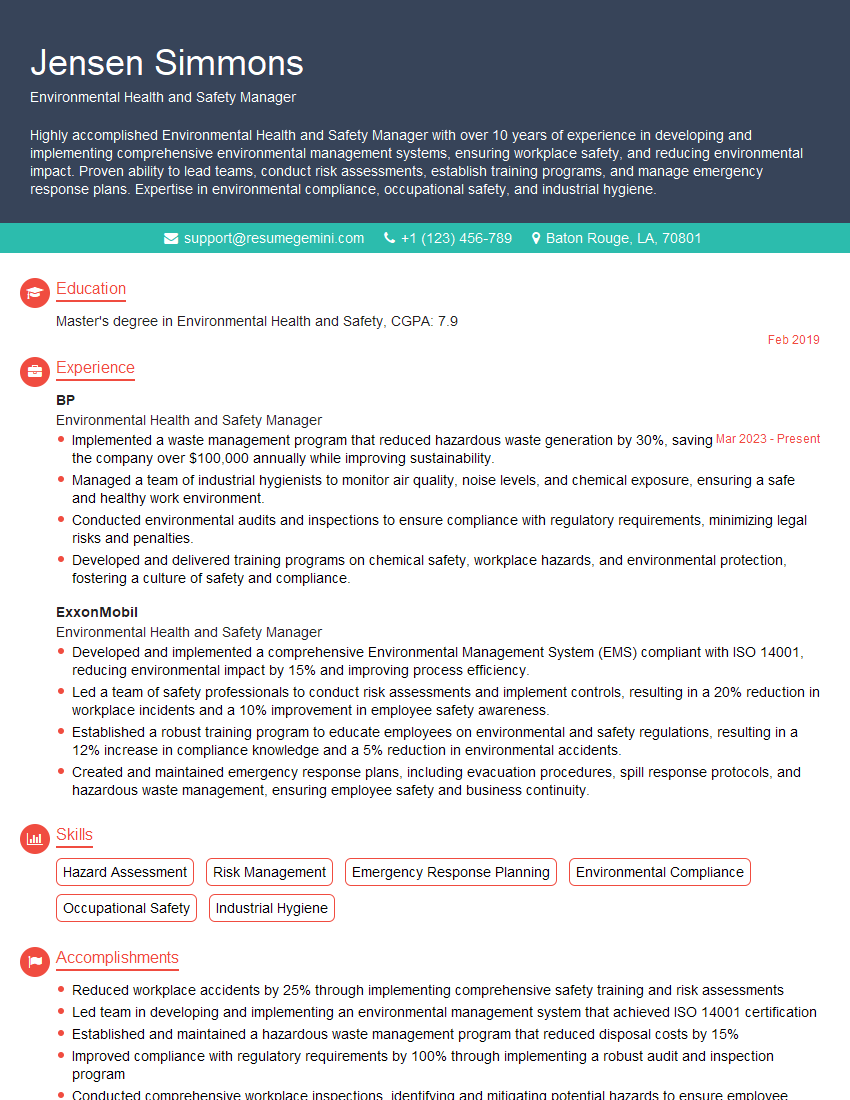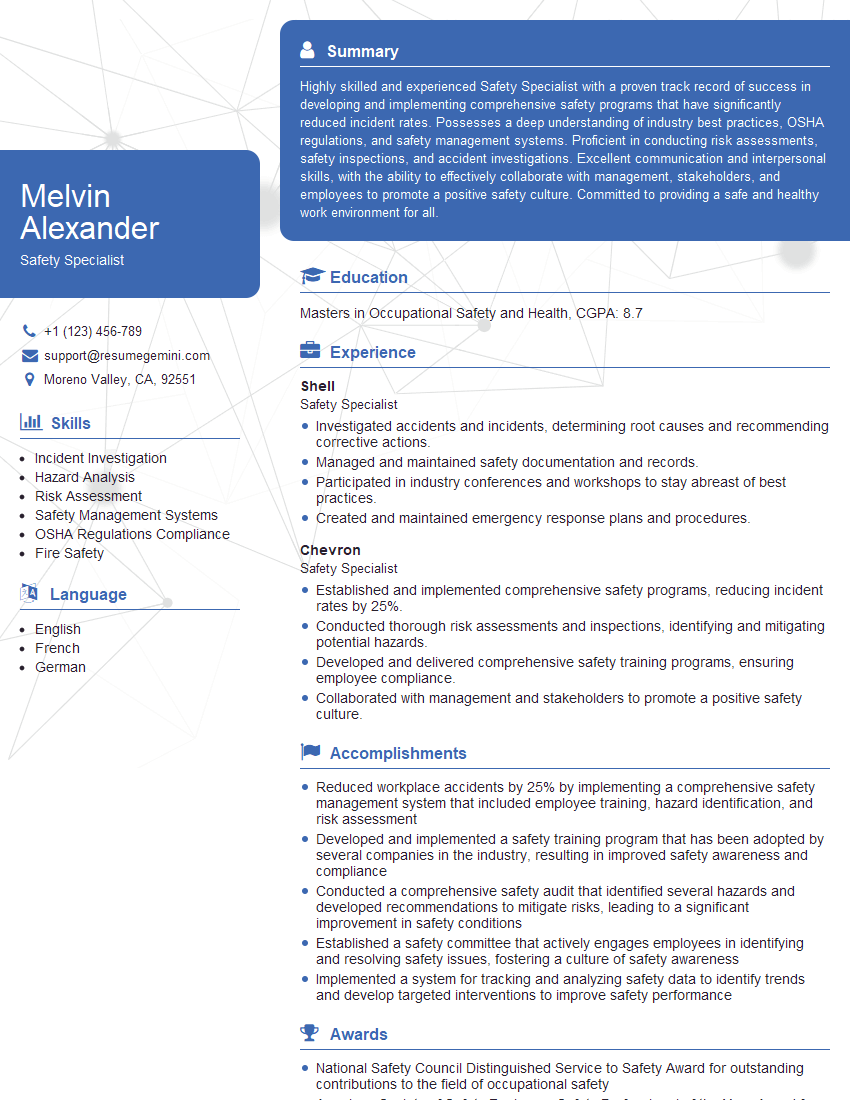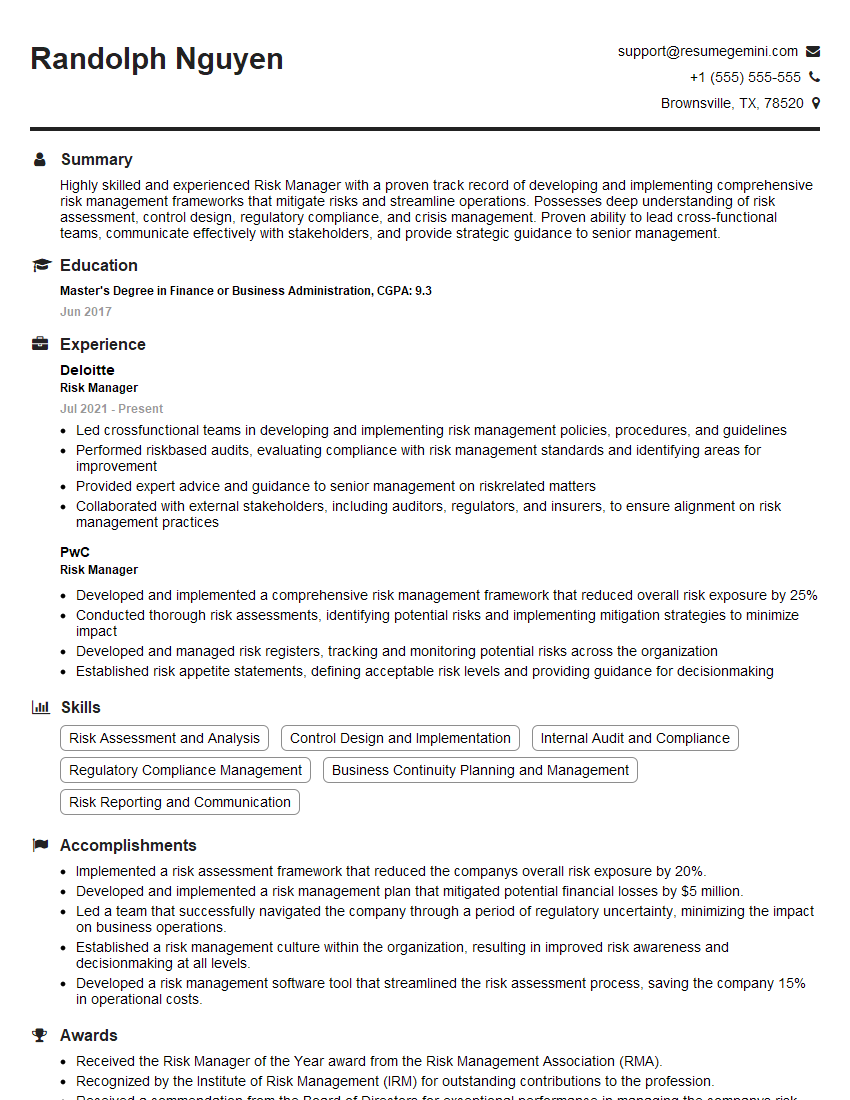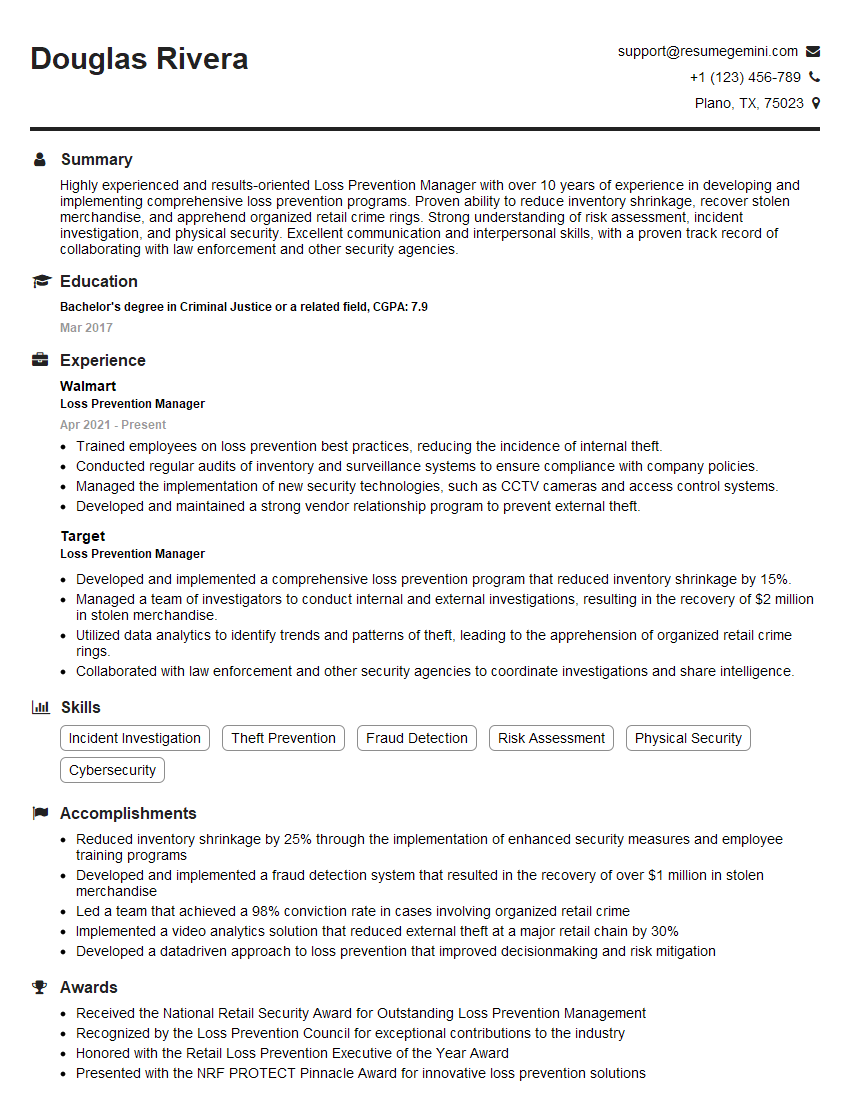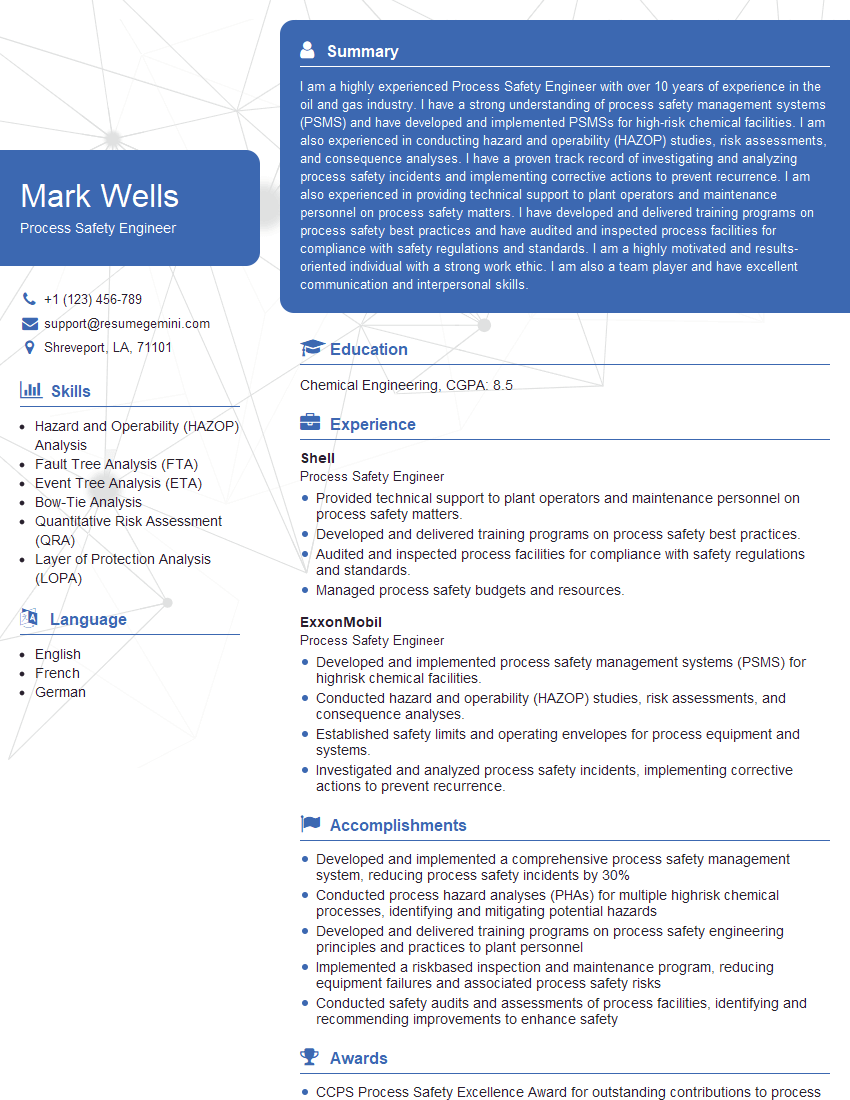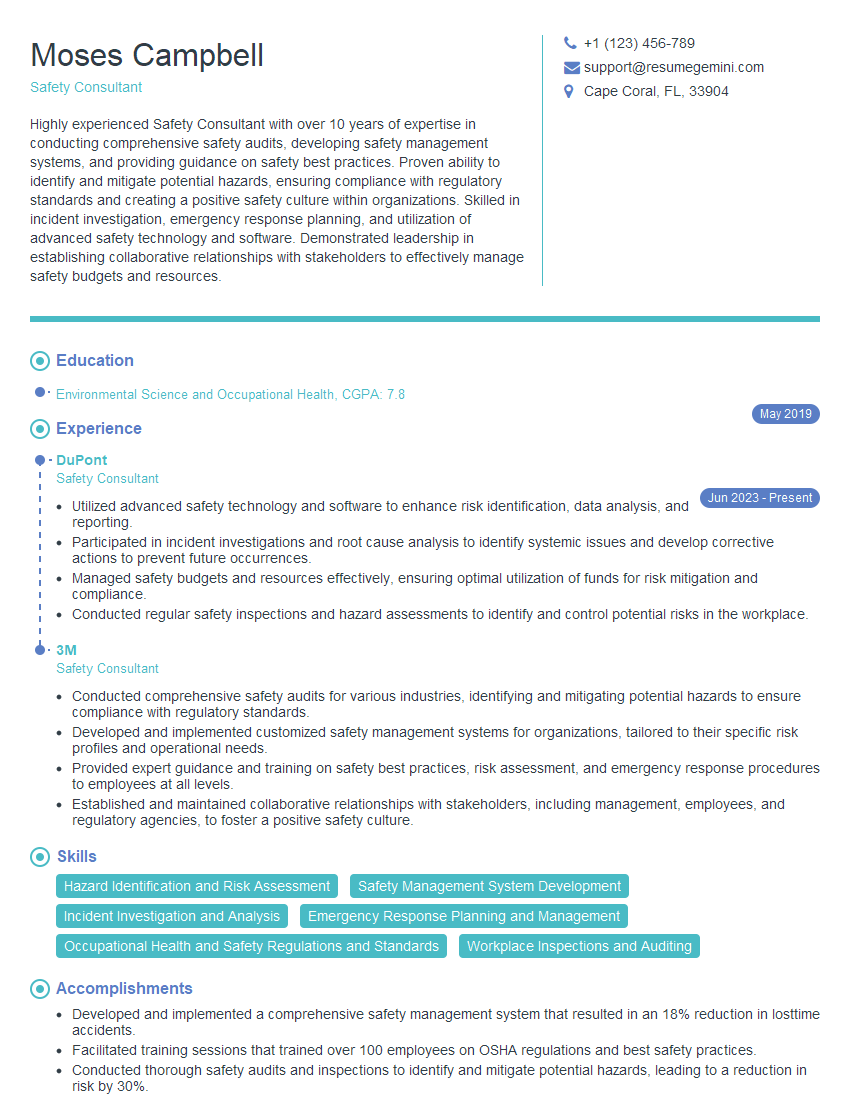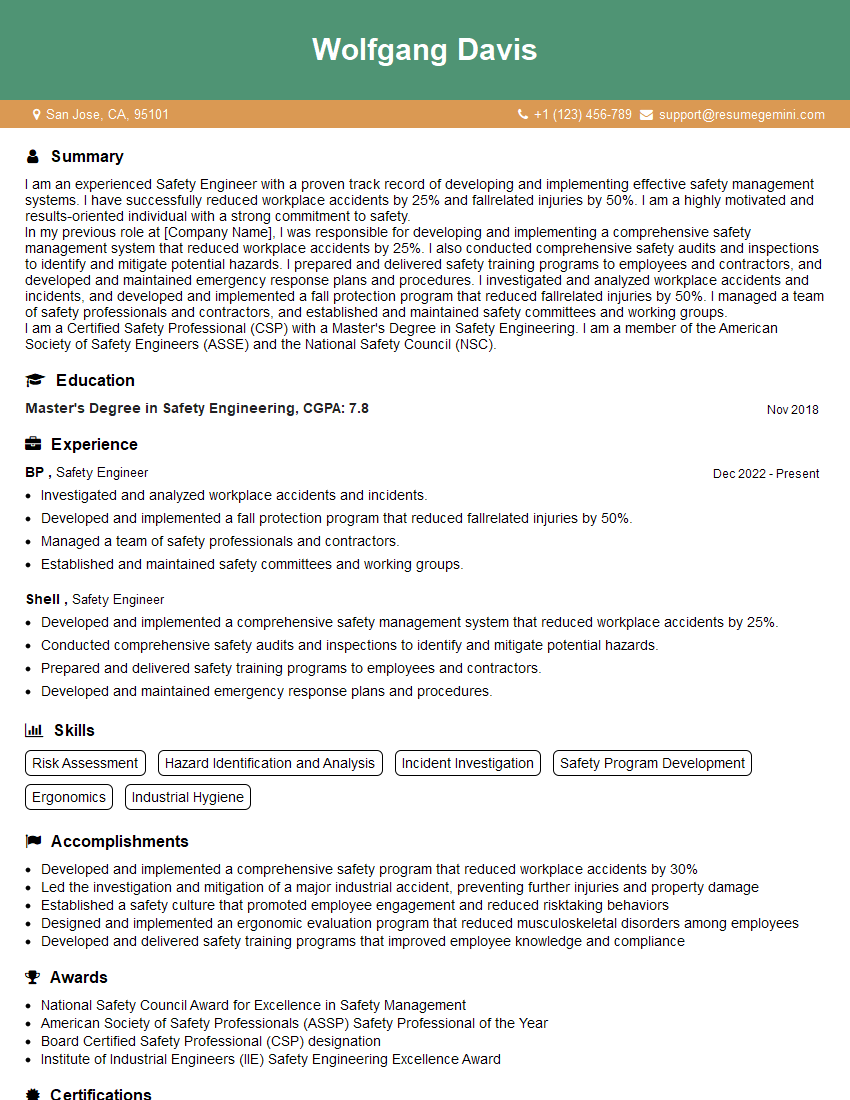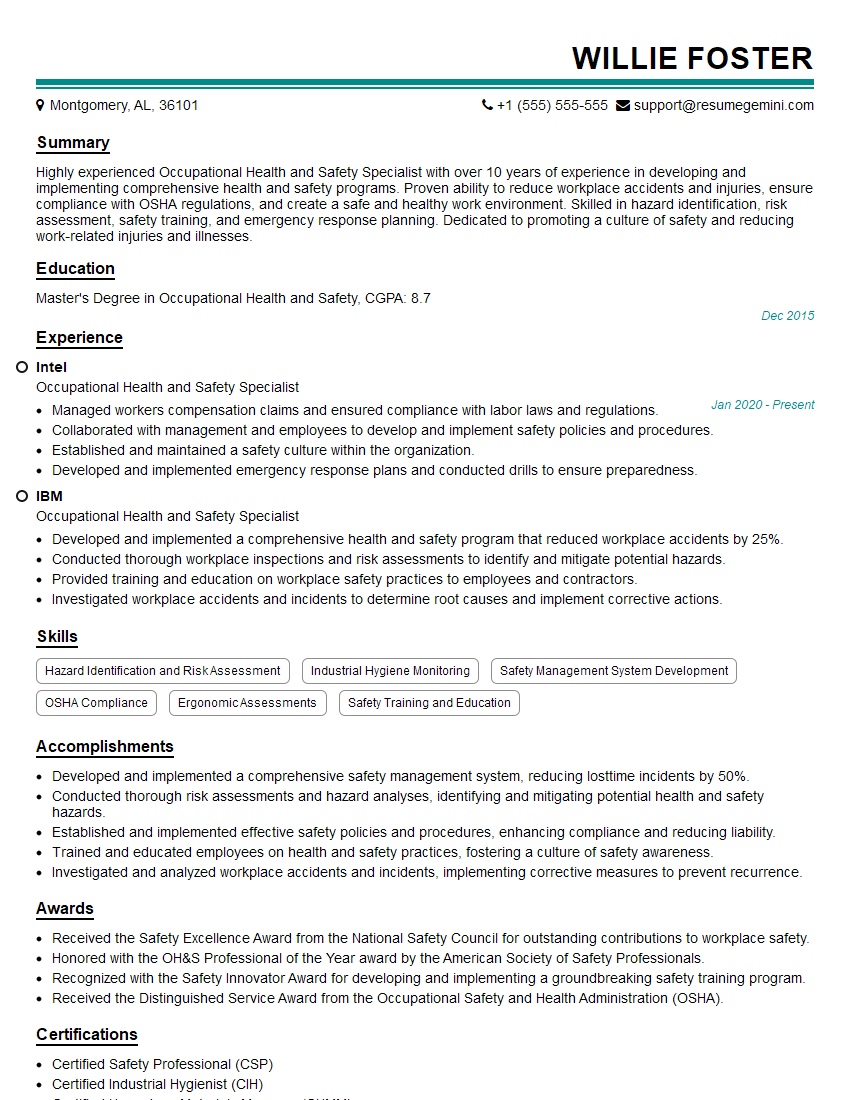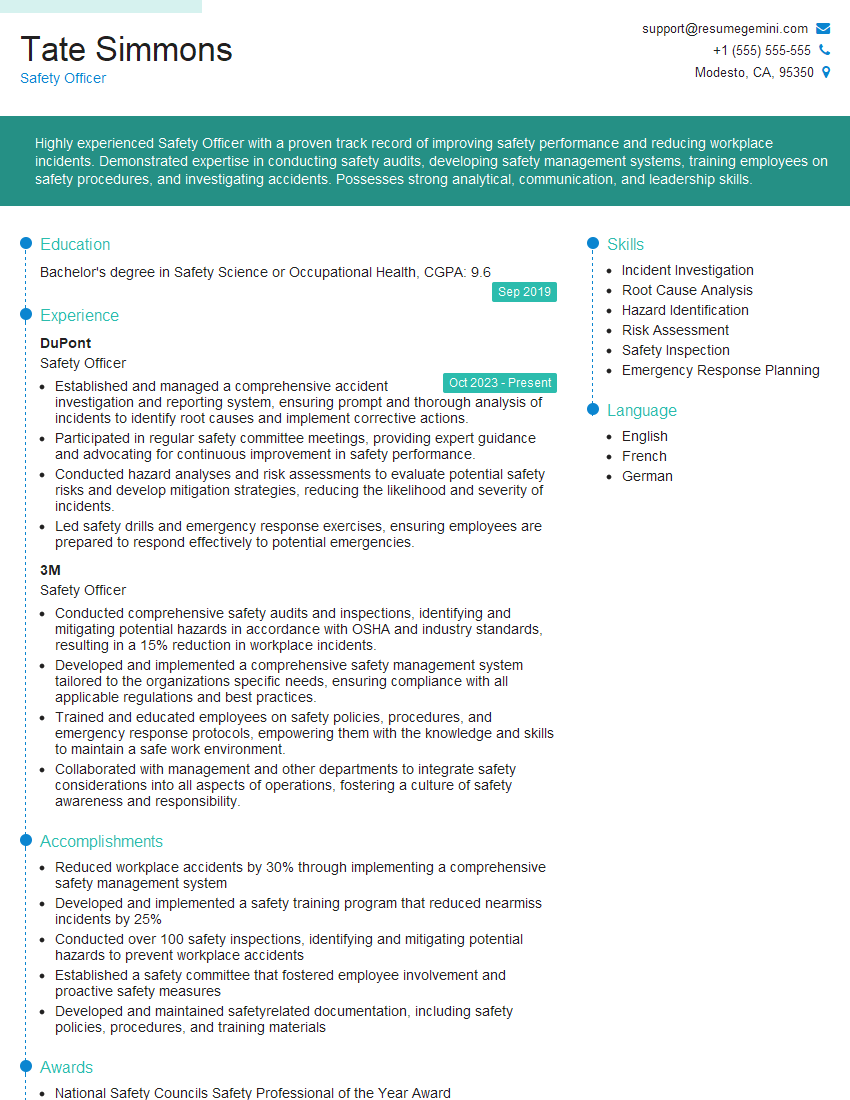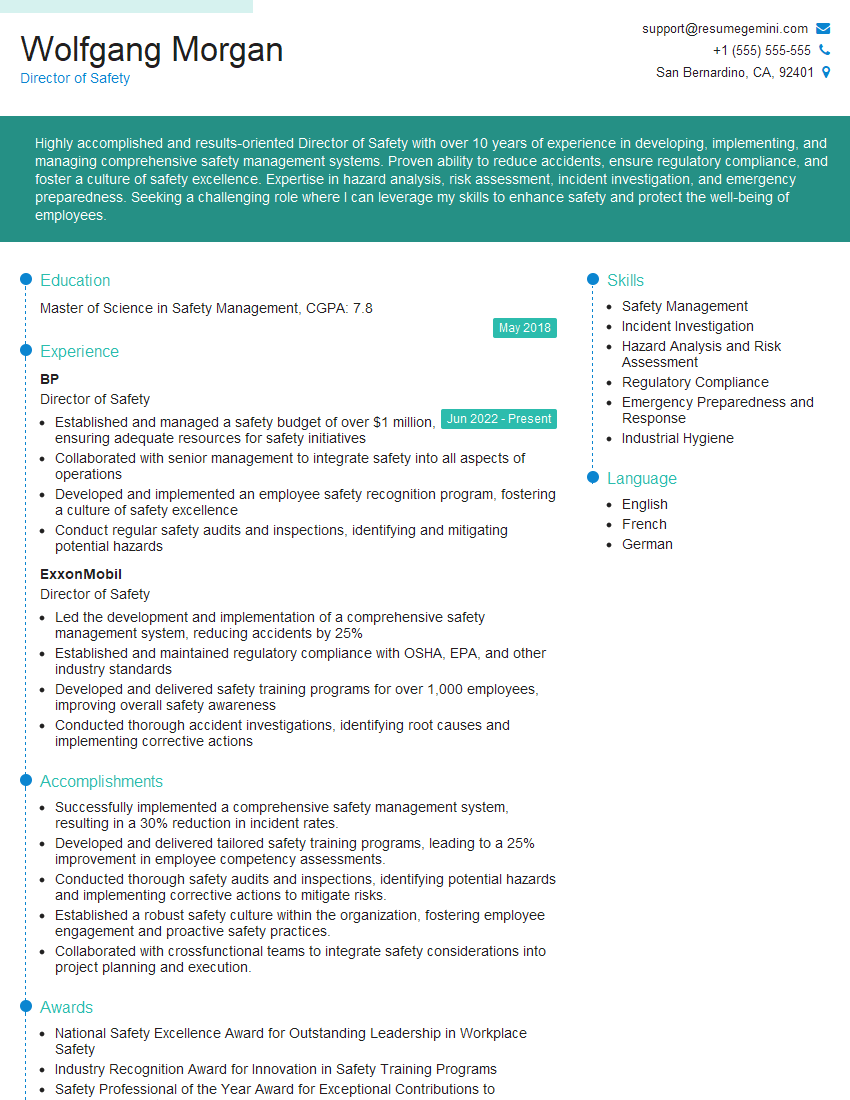The right preparation can turn an interview into an opportunity to showcase your expertise. This guide to Safety Debriefing interview questions is your ultimate resource, providing key insights and tips to help you ace your responses and stand out as a top candidate.
Questions Asked in Safety Debriefing Interview
Q 1. Describe your experience conducting safety debriefings.
My experience in conducting safety debriefings spans over ten years across various industries, including construction, manufacturing, and healthcare. I’ve facilitated hundreds of debriefings, ranging from small team discussions to large-scale incident investigations. I’ve consistently focused on creating a safe space for open communication and honest feedback, prioritizing the identification of hazards and near misses to prevent future incidents. For instance, during a construction project, a near miss involving a crane operator nearly dropping a load highlighted the need for improved communication protocols. The subsequent debriefing led to the implementation of a new hand-signal system and improved pre-lift checks, significantly reducing the risk of similar incidents. In manufacturing, I’ve led debriefings after machine malfunctions, analyzing root causes and implementing corrective actions to prevent equipment failure and potential injury.
Q 2. What are the key elements of an effective safety debriefing?
An effective safety debriefing hinges on several key elements: Firstly, a structured approach is crucial. This includes a clear objective, a defined timeline, and a pre-determined agenda. Secondly, fostering a blame-free environment is paramount. Participants need to feel comfortable sharing information without fear of retribution. Thirdly, active listening and facilitation from the leader are essential. The facilitator should guide the discussion, encourage participation from all members, and ensure everyone feels heard. Fourthly, focused discussion on specific incidents, near misses, and observations is vital. Fifthly, and finally, the debriefing must result in concrete actionable steps. These steps should include specific tasks, assigned responsibilities, and timelines for completion. This ensures the debriefing isn’t just a discussion, but a catalyst for change.
Q 3. How do you ensure all participants actively contribute to a safety debriefing?
Ensuring active participation requires a multi-pronged approach. I begin by clearly outlining the purpose of the debriefing and emphasizing the importance of everyone’s input. I use techniques like round-robin questioning, where each participant shares their observations. I also employ open-ended questions to encourage detailed responses and avoid simple ‘yes’ or ‘no’ answers. Visual aids, like photos or diagrams of the incident or area, can stimulate discussion. I also actively listen and respond to each contribution, showing appreciation for their participation and creating a safe space for sharing differing opinions. Sometimes, a less formal setting, such as a casual team lunch, can break down barriers and encourage more open communication.
Q 4. Explain your process for identifying and addressing safety concerns raised during a debriefing.
My process for identifying and addressing safety concerns follows a structured methodology. First, I systematically document all observations and concerns raised during the debriefing. This usually involves note-taking or using a dedicated software for recording the session. Secondly, I categorize the concerns based on their severity and potential impact. This helps prioritize actions. Thirdly, for each concern, we collaboratively identify the root causes using techniques like the ‘5 Whys’ analysis. Finally, we develop specific, measurable, achievable, relevant, and time-bound (SMART) corrective actions. These actions are assigned to specific individuals with clear deadlines for implementation and follow-up. We then track the progress of these actions, ensuring accountability and closure.
Q 5. How do you handle disagreements or conflicting perspectives during a safety debriefing?
Disagreements or conflicting perspectives are inevitable in safety debriefings. I handle these by facilitating a respectful discussion, emphasizing the importance of diverse viewpoints. I encourage participants to explain their perspectives clearly, providing opportunities for clarification and understanding. I often use visual aids or data to support arguments. If the disagreement cannot be resolved, I document the different perspectives and seek input from other stakeholders, possibly escalating the issue to a higher level of management if necessary. The key is to ensure all viewpoints are acknowledged and considered, and a decision is made that prioritizes safety.
Q 6. How do you tailor your debriefing approach to different teams or situations?
I tailor my approach to different teams and situations by considering their experience, culture, and the nature of the task or incident. For instance, a debriefing with a newly formed team may require more structured guidance and clear explanations, whereas a seasoned team may benefit from a more open-ended and less directive approach. The language and technical terminology used are also adjusted accordingly. In situations involving serious incidents, a more formal and thorough investigation might be necessary, while a near miss may require a less formal discussion focusing on lessons learned. The overall goal remains consistent: to identify hazards, improve safety practices, and prevent future incidents.
Q 7. What methods do you use to document and track findings from safety debriefings?
I use a combination of methods for documenting and tracking findings. Detailed minutes are taken during the debriefing and then transcribed and distributed to all participants. Action items, assigned responsibilities, and deadlines are clearly documented. I also use a dedicated safety management system (SMS) or spreadsheet to track the progress of corrective actions. These systems allow for regular monitoring of implementation and effectiveness. Follow-up debriefings or site visits may be conducted to assess the effectiveness of the implemented actions. The goal is to ensure a clear audit trail of all findings, actions, and their outcomes, ensuring continuous improvement in safety performance.
Q 8. How do you ensure the action items from a safety debriefing are followed up on?
Following up on action items is crucial for the effectiveness of any safety debriefing. It’s not enough to simply identify issues; we must ensure corrective actions are taken. My approach involves a multi-step process. First, during the debriefing itself, we assign clear ownership for each action item, specifying a responsible person and a deadline. This is documented in meeting minutes, distributed to all attendees immediately afterwards. Second, I utilize a task management system – often a shared spreadsheet or project management software – to track progress. This allows me to monitor deadlines and identify any potential roadblocks. Third, I conduct regular follow-ups, either through individual check-ins or group updates, to ensure tasks are progressing as planned. Finally, we revisit action items in subsequent debriefings to assess effectiveness and identify any lingering issues. For instance, if a safety hazard was identified due to improperly stored equipment, the follow-up would involve verifying that the storage solution implemented is adequate and that the team is adhering to the new procedures. Ignoring this follow-up could lead to a recurrence of the incident, undermining the entire purpose of the debriefing.
Q 9. Describe a time you had to handle a difficult or challenging situation during a safety debriefing.
During a debriefing following a near-miss incident involving a forklift, one team member became visibly defensive when questioned about their adherence to safety protocols. They initially blamed equipment malfunction, refusing to acknowledge their own potential contribution to the near-miss. I handled this by first acknowledging their feelings and validating their concerns. I emphasized that the purpose of the debrief was not to assign blame but to learn from the event to prevent future occurrences. I then steered the conversation back to the objective facts, encouraging them to describe the events leading up to the near miss without interruption. Through careful questioning and active listening, I helped the team member identify their own lapses in judgment without making them feel personally attacked. We collaboratively brainstormed solutions, including additional training on forklift safety and improvements to the equipment checklist. The outcome was a more robust safety plan and a renewed commitment from all team members to follow procedures.
Q 10. What are some common pitfalls to avoid when conducting safety debriefings?
Several pitfalls can hinder the effectiveness of safety debriefings. One common issue is a lack of preparation. Without a structured agenda and clear objectives, the debriefing can become disorganized and unproductive. Another pitfall is dominance by senior personnel; a less experienced worker may be hesitant to speak up if a senior team member dominates the conversation. This necessitates creating a safe space where everyone feels comfortable sharing their observations and concerns. A third common problem is failing to address root causes, focusing on immediate fixes rather than the underlying issues. Finally, neglecting to follow up on action items renders the debriefing meaningless. A well-structured, inclusive, and thorough debriefing ensures a focused and effective outcome.
Q 11. How do you ensure confidentiality during a safety debriefing?
Confidentiality is paramount in safety debriefings. People are more likely to openly discuss near-misses or safety concerns if they feel comfortable doing so without fear of reprisal. To ensure confidentiality, I always emphasize at the beginning of each debriefing that all discussions will remain within the group. We avoid identifying individuals publicly unless absolutely necessary to address a specific action item. If specific individuals need to be named, permission is obtained first. Any written documentation, including meeting minutes, is securely stored and access is limited to relevant personnel. The information shared is considered privileged and is not used for disciplinary purposes unless there is evidence of gross negligence or willful disregard for safety regulations. It’s crucial to build trust and reinforce the understanding that this is a learning process, not a blame game.
Q 12. How do you use data from safety debriefings to improve safety performance?
Data from safety debriefings are invaluable for continuous improvement. We track the types of incidents reported, their frequency, and the contributing factors. This data informs our risk assessments, allowing us to identify recurring issues and prioritize areas needing attention. For example, if we consistently see near-misses related to a specific piece of equipment, we might initiate a review of that equipment’s maintenance schedule or provide additional training on its safe operation. We analyze trends over time to measure the effectiveness of our interventions and identify any emerging safety concerns. By analyzing this data, we are able to proactively adjust our safety policies and procedures, leading to a safer work environment and a reduction in incidents. Data visualization tools, like charts and graphs, are especially useful to illustrate these trends.
Q 13. What safety regulations or standards inform your approach to safety debriefings?
My approach to safety debriefings is guided by several key regulations and standards. These include OSHA guidelines (in the United States), relevant industry-specific regulations (such as those pertaining to construction or transportation), and international standards like ISO 45001 (Occupational health and safety management systems). These standards provide a framework for identifying hazards, assessing risks, and developing control measures. They also outline best practices for conducting investigations and documenting findings. My approach incorporates the principles of hazard identification, risk assessment, and control outlined in these regulations and standards. Compliance ensures we maintain a legally compliant and safe work environment, and adhering to best practices helps make the debriefing more effective and insightful.
Q 14. How do you ensure the debriefing remains focused and efficient?
Maintaining focus and efficiency in a safety debriefing requires careful planning and execution. We start with a pre-determined agenda, sharing it in advance with all attendees. Time limits are set for each discussion point to ensure all topics are covered within the allocated time. A designated facilitator guides the discussion, keeping it on track and ensuring all voices are heard. We use visual aids, like photos or diagrams, to illustrate points and enhance understanding. Active listening and concise communication are encouraged. The facilitator summarizes key findings and action items at the end of the debriefing to confirm everyone is on the same page. This structured approach ensures the debriefing is productive, valuable, and doesn’t become bogged down in irrelevant details.
Q 15. How do you encourage open and honest communication during a safety debriefing?
Creating a safe space for open and honest communication during a safety debriefing is crucial. It’s about fostering a culture of trust where individuals feel comfortable sharing information without fear of blame or retribution. This starts before the debriefing even begins.
Establish Ground Rules: At the outset, clearly state that the purpose is learning and improvement, not assigning blame. Emphasize confidentiality and respect for all participants’ contributions. A simple phrase like, “Remember, we’re all here to learn from this experience and prevent future incidents,” can set the tone.
Active Listening: As the facilitator, demonstrate active listening through nonverbal cues (nodding, maintaining eye contact) and verbal affirmations (“I understand,” “That’s a valuable point”). Ask clarifying questions to ensure everyone understands each other’s perspectives.
Anonymous Feedback Mechanisms: Consider incorporating anonymous feedback options, like suggestion boxes or online forms, especially if sensitive issues might be involved. This can encourage individuals who might hesitate to speak up openly in a group setting to share valuable insights.
Psychological Safety: Cultivate a culture of psychological safety, where individuals feel comfortable taking risks and speaking up without fear of negative consequences. This requires consistent reinforcement of the ground rules and demonstrating a commitment to learning from mistakes rather than punishing them.
For instance, in a construction site debriefing following a near-miss incident, I would explicitly state that the goal is to identify potential hazards and improve safety protocols, not to point fingers at individuals. Active listening ensured everyone’s input was valued, leading to the identification of a previously overlooked safety procedure that significantly reduced future risks.
Career Expert Tips:
- Ace those interviews! Prepare effectively by reviewing the Top 50 Most Common Interview Questions on ResumeGemini.
- Navigate your job search with confidence! Explore a wide range of Career Tips on ResumeGemini. Learn about common challenges and recommendations to overcome them.
- Craft the perfect resume! Master the Art of Resume Writing with ResumeGemini’s guide. Showcase your unique qualifications and achievements effectively.
- Don’t miss out on holiday savings! Build your dream resume with ResumeGemini’s ATS optimized templates.
Q 16. Describe your experience with different debriefing methods (e.g., formal, informal).
My experience encompasses both formal and informal debriefing methods. Formal debriefings are structured, often documented, and may involve multiple stakeholders. Informal debriefings are more casual, often occurring immediately after an event, and are particularly useful for quick feedback and immediate hazard mitigation.
Formal Debriefings: These typically involve a pre-defined agenda, a designated facilitator, and a documented record of findings and actions. I use formal methods for significant incidents, requiring a thorough investigation and comprehensive documentation for regulatory compliance and continuous improvement. These may include the use of specific root cause analysis techniques like the Five Whys or Fishbone diagrams.
Informal Debriefings: These are more spontaneous, often occurring at the job site immediately following a near-miss or minor incident. Their value lies in addressing issues promptly before they escalate. A simple conversation between a supervisor and a worker to discuss a slip, trip, or fall, and to immediately address the underlying cause (e.g., wet floor not properly marked), is a prime example. These are valuable for immediate corrective actions.
Incident Investigation and Reporting: Regardless of the formality, my approach emphasizes documenting the incident, identifying contributing factors, and developing corrective actions. This ensures accountability and prevents recurrence.
For example, I’ve facilitated formal debriefings following major equipment malfunctions, employing the 5 Whys method to drill down to the root cause. I’ve also conducted countless informal debriefings after minor incidents, often leading to immediate adjustments to work practices that prevent similar incidents.
Q 17. How do you adapt your communication style to meet the needs of diverse audiences in a safety debriefing?
Adapting communication style to diverse audiences requires sensitivity and awareness. It’s essential to consider language barriers, literacy levels, cultural differences, and individual communication preferences. I strive to ensure inclusivity and effective understanding.
Language Accessibility: If language barriers exist, I arrange for translation services or use visual aids. Simple and clear language is paramount, avoiding jargon and technical terms whenever possible.
Visual Aids and Demonstrations: Using visual aids such as diagrams, photos, or videos enhances comprehension, particularly for those with different literacy levels. Demonstrations of proper procedures can be incredibly effective.
Cultural Sensitivity: I am mindful of cultural norms and communication styles. In some cultures, direct confrontation may be inappropriate, while in others, open and direct communication is the norm. Adapting my approach to respect these differences is key.
Active Engagement: I regularly check for understanding by asking questions, summarizing key points, and encouraging feedback. This ensures everyone is on the same page and feeling comfortable contributing.
For instance, while debriefing a team with diverse language skills after a safety incident, I used visual aids, translated key terminology, and ensured all team members had the opportunity to share their experience in their preferred language. This ensured that information was clearly conveyed and valuable feedback was gathered.
Q 18. What techniques do you use to identify root causes of safety incidents during a debriefing?
Identifying root causes requires a systematic approach, going beyond surface-level observations. I frequently utilize techniques like the Five Whys, Fishbone diagrams, and Fault Tree Analysis.
The Five Whys: This iterative questioning technique helps to peel back layers of explanation to uncover underlying causes. By repeatedly asking “Why?” you progressively identify the root cause(s) of an event.
Fishbone Diagrams (Ishikawa Diagrams): This visual tool helps to categorize contributing factors into major categories (e.g., people, methods, materials, equipment, environment). It fosters a collaborative approach, encouraging the participation of multiple individuals to identify potential causes.
Fault Tree Analysis (FTA): A deductive analysis technique that starts with the undesired event and works backward to identify potential contributing factors. This is especially useful for complex incidents with multiple contributing factors.
Data Analysis: Examining relevant data, such as incident reports, maintenance logs, and operational records provides valuable context and information to identify patterns or contributing factors that might otherwise be overlooked.
For example, in a debriefing following a vehicle accident, using the Five Whys might reveal that the root cause wasn’t simply “driver error,” but rather inadequate training on safe driving procedures, leading to a lack of awareness of hazardous conditions.
Q 19. How do you measure the effectiveness of your safety debriefings?
Measuring the effectiveness of safety debriefings involves both qualitative and quantitative measures. The goal is to track improvements in safety performance and identify areas needing further attention.
Reduction in Incident Rates: A key metric is the reduction in the frequency and severity of safety incidents after implementing changes derived from debriefings. Tracking leading indicators, such as near-miss reports, can also provide valuable insight.
Employee Feedback Surveys: Surveys gauge employee perceptions of the effectiveness of debriefings, assessing whether they feel comfortable raising concerns and if they believe the process leads to meaningful improvements.
Observation of Improved Safety Practices: Direct observation of workplace practices helps to determine if identified safety improvements have been adopted and are being consistently followed.
Analysis of Corrective Actions: Tracking the implementation and effectiveness of corrective actions identified during debriefings demonstrates the value of the process and helps identify areas that require ongoing improvement.
For instance, by tracking the number of near-miss incidents before and after implementing changes from debriefings, we can quantitatively assess the effectiveness of the process. Employee feedback surveys provide qualitative data on the value of the debriefing sessions and employee engagement.
Q 20. What technology or tools do you utilize to support your safety debriefing process?
Technology and tools significantly enhance the safety debriefing process, allowing for greater efficiency, collaboration, and data analysis.
Software for Incident Reporting and Investigation: Dedicated software facilitates the efficient recording and tracking of incidents, contributing factors, and corrective actions. This allows for easier analysis of trends and patterns.
Video Conferencing: For geographically dispersed teams, video conferencing tools make it possible to conduct debriefings remotely, facilitating participation and improving timeliness.
Digital Whiteboards and Collaboration Tools: These tools enable real-time collaboration during debriefings, allowing participants to collectively brainstorm solutions and document findings.
Data Analytics Platforms: These tools allow the analysis of large datasets related to safety incidents, revealing patterns and trends which can inform improvements in safety programs.
For example, using dedicated software to capture incident details and track corrective actions significantly reduces manual effort and improves data accuracy. Video conferencing allows us to quickly conduct debriefings with individuals who may be off-site, minimizing downtime.
Q 21. How do you balance the need for thoroughness with the need for efficiency in safety debriefings?
Balancing thoroughness and efficiency is a critical skill in safety debriefings. The aim is to conduct thorough investigations while avoiding unnecessary delays or excessive bureaucracy.
Prioritization: Focus on the most critical aspects first, addressing immediate hazards and high-risk situations promptly. Less critical issues can be addressed later.
Structured Approach: Use a structured approach, such as a pre-defined agenda or checklist, to ensure all essential information is collected efficiently.
Time Management: Set clear time limits for the debriefing and stick to them. This helps maintain focus and prevents the process from dragging on unnecessarily.
Clear Roles and Responsibilities: Assign clear roles and responsibilities to team members to avoid duplication of effort and ensure everyone is accountable for specific tasks.
For example, in a debriefing following a near-miss incident, I would prioritize gathering information about the immediate circumstances and identifying the root cause before delving into less crucial aspects of the event. Setting a time limit for the session prevents it from becoming overly time-consuming.
Q 22. Explain your understanding of incident investigation and its relationship to safety debriefings.
Incident investigation is a systematic process of identifying the root causes of accidents or near misses, while safety debriefings are informal discussions that aim to identify lessons learned and prevent future incidents. They are intrinsically linked; investigations provide the factual data, while debriefings facilitate the sharing and application of those findings to improve safety. A thorough investigation informs a productive debriefing, ensuring everyone understands the ‘why’ behind an incident, not just the ‘what’.
For example, an investigation into a fall from height might reveal inadequate safety harness use. The subsequent debriefing would focus on why harnesses weren’t used correctly – was training insufficient? Were harnesses uncomfortable or inconvenient? Were there time pressures influencing behavior? Addressing these underlying issues is crucial to preventing future incidents.
Q 23. How do you incorporate lessons learned from past incidents into your safety debriefings?
I incorporate lessons from past incidents into safety debriefings by using them as case studies. This isn’t about blame, but rather about proactive learning. I’ll present a summarized account of the incident, highlighting the root causes and the consequences. Then, we discuss the corrective actions that were taken, analyzing their effectiveness. This facilitates a constructive conversation around what could have been done differently and what preventative measures can be put in place to avoid similar situations.
For instance, if a previous debriefing revealed a problem with inadequate communication during a complex procedure, I might begin a new debriefing with a reminder of that incident and discuss how improved communication protocols could prevent similar issues. I might even use a checklist or flowchart to visualize and simplify the improved communication process.
Q 24. How do you ensure that safety debriefings contribute to a positive safety culture?
Safety debriefings contribute to a positive safety culture by fostering a blame-free environment where everyone feels comfortable speaking up about near misses and potential hazards. I achieve this by emphasizing the importance of learning from mistakes rather than assigning blame. This means creating a space where honesty is valued, and reporting errors is seen as a crucial part of maintaining safety.
- Open communication: I encourage open dialogue, ensuring all voices are heard.
- Respectful environment: I ensure a respectful atmosphere that values different perspectives.
- Positive reinforcement: I acknowledge and praise positive safety behaviors.
- Actionable outcomes: I ensure that debriefings result in concrete, actionable items that are implemented and followed up on.
The positive reinforcement of safety behaviors is key – celebrating a near miss averted by quick thinking shows that identifying risks is valued, encouraging future reporting.
Q 25. What is your approach to facilitating participation from less vocal members in a debriefing?
To engage less vocal members, I employ several strategies. Firstly, I use a structured format, employing visual aids like whiteboards or flip charts to encourage participation. I ensure that questions are posed to the group, not just directed at individuals. This encourages quieter members to contribute. I also use anonymous feedback methods like suggestion boxes or online forms for those who might feel uncomfortable speaking up directly.
One technique I find particularly effective is to start with easy, open-ended questions like ‘What went well today?’ This establishes a positive tone and encourages participation, gradually moving to more specific, challenging questions. I often personally check-in with quieter individuals after the debrief, giving them another opportunity to share their thoughts.
Q 26. Describe a time you had to adapt your debriefing approach due to unexpected circumstances.
During a routine post-shift debriefing at a construction site, we experienced a sudden and severe thunderstorm. The scheduled outdoor debriefing had to be immediately moved indoors. Instead of halting the debriefing, I quickly adapted by using the available space, a small, crowded office, and transitioned to a more focused discussion using a smaller whiteboard and prioritizing the most critical safety concerns. We concentrated on immediate actions necessary to secure the site and prioritize worker safety during the storm. This required a shift away from planned agenda items, focusing instead on the immediate threat.
This experience highlighted the importance of flexibility and adaptability in debriefings. The ability to quickly reassess the situation and prioritize immediate needs is vital for effectiveness.
Q 27. How do you ensure that the information shared during a safety debriefing is properly disseminated?
Dissemination of debriefing information is crucial. I use a multi-pronged approach. First, I create concise minutes from each debriefing, documenting key findings, discussions, and action items. These are then distributed to all relevant parties via email. I also utilize a centralized safety management system (if one exists) to log incidents and track the progress of action items. This ensures easy access to information for future reference. Finally, key findings and lessons learned are often incorporated into future training programs or safety alerts to ensure widespread understanding and application.
For example, if a recurring issue is identified, a short video or infographic summarizing the issue and best practices might be created and distributed, to reinforce understanding.
Q 28. What are some examples of effective action items that have resulted from safety debriefings you’ve conducted?
Several effective action items have resulted from debriefings I’ve conducted. One example involved a near miss where a worker almost fell from a ladder. The debriefing revealed that the ladder was damaged and wasn’t properly secured. As a direct result, a comprehensive ladder inspection program was implemented, leading to the immediate removal of damaged ladders and enhanced training on proper ladder safety.
Another example involved a near-collision between a forklift and a pedestrian. The debriefing highlighted the lack of clear signage in the warehouse. This led to the installation of additional warning signs, improved pedestrian walkways, and the implementation of a new traffic management system, significantly reducing the risk of future collisions.
Key Topics to Learn for Safety Debriefing Interview
- Incident Investigation Fundamentals: Understanding root cause analysis techniques, contributing factors, and the importance of accurate data collection in safety debriefings.
- Effective Communication Strategies: Mastering active listening, non-judgmental feedback delivery, and techniques for fostering open communication within a safety debriefing environment. Practical application: Role-playing different communication scenarios to handle various personalities and emotional responses.
- Behavioral Safety Observations: Identifying and analyzing unsafe behaviors, near misses, and potential hazards. Practical application: Describing how to use observation data to improve safety protocols and training programs.
- Corrective Action Planning: Developing and implementing effective corrective actions based on debriefing findings. This includes prioritizing actions, assigning responsibilities, and establishing timelines for implementation and follow-up.
- Regulatory Compliance: Demonstrating knowledge of relevant safety regulations and standards and how they influence the debriefing process. Practical application: Explaining how to ensure compliance is addressed during and after a safety debriefing.
- Human Factors in Safety: Understanding the role of human error, fatigue, and stress in incidents, and how to address these factors during debriefings. Practical application: Describing strategies to mitigate human error through improved training, procedures, and equipment.
- Data Analysis and Reporting: Using data from debriefings to identify trends, improve safety performance, and inform management decisions. Practical application: Explaining methods for creating effective safety reports based on debriefing data.
Next Steps
Mastering safety debriefing techniques is crucial for advancing your career in safety-critical industries. A strong understanding of these principles demonstrates your commitment to workplace safety and your ability to contribute effectively to a proactive safety culture. To significantly enhance your job prospects, it’s essential to create a compelling and ATS-friendly resume that highlights your skills and experience. ResumeGemini is a trusted resource that can help you build a professional resume that makes you stand out. Examples of resumes tailored to Safety Debriefing are available within ResumeGemini to provide you with a strong template to build upon. Invest the time to craft a resume that reflects your expertise; it’s an investment in your future success.
Explore more articles
Users Rating of Our Blogs
Share Your Experience
We value your feedback! Please rate our content and share your thoughts (optional).
What Readers Say About Our Blog
Hi, I represent an SEO company that specialises in getting you AI citations and higher rankings on Google. I’d like to offer you a 100% free SEO audit for your website. Would you be interested?
good
